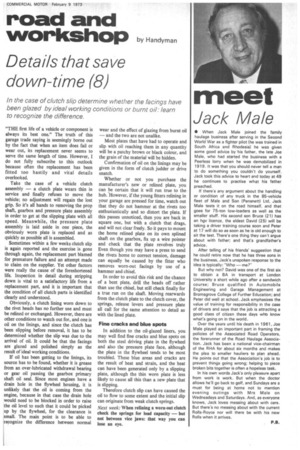road and workshop
Page 39

If you've noticed an error in this article please click here to report it so we can fix it.
by Handyman
Details that save down-time (8)
In the case of clutch slip determine whether the facings have been glazed by ideal working conditions or burnt oil: learn to recognize the difference.
"THE first life of a vehicle or component is always its best one." The truth of this garage trade saying is seemingly borne out by the fact that when an item does fail or wear out, its replacement never seems to serve the same length of time. However, I do not fully subscribe to this outlook because often the replacement has been fitted too hastily and vital details overlooked.
Take the case of a vehicle clutch assembly — a clutch plate wears thin in service and finally refuses to move the vehicle; no adjustment will regain the lost grip. So it's all hands to removing the prop shaft, gearbox and pressure plate assembly in order to get at the slipping plate with all speed. Meanwhile, the pressure plate assembly is laid aside in one piece, the obviously worn plate is replaced and as quickly as possible all is assembled.
Sometimes within a few weeks clutch slip is again reported and the exercise is gone through again, the replacement part blamed for premature failure and an attempt made to claim on the supplier. Yet other factors were really the cause of the foreshortened life. Inspection in detail during stripping down is vital to a satisfactory life from a replacement part, and it is important that the condition of all clutch parts is identified clearly and understood.
Obviously, a clutch lining worn down to the rivet heads has no further use and must be relined or exchanged. However, there are other conditions to watch out for, and one is oil on the linings, and since the clutch has been slipping before removal, it has to be determined whether the slip was due to the arrival of oil. It could be that the facings are glazed and polished simply as the result of ideal working conditions.
If oil has been getting to the linings, its source has to be found, whether it is grease from an over-lubricated withdrawal bearing or gear oil passing the gearbox primary shaft oil seal. Since most engines have a drain hole in the flywheel housing, it is unlikely that the oil is coming from the engine, because in that case the drain hole would need to be blocked in order to raise the oil level to such that it could be picked up by the flywheel, for the clearance is small. The main point is to be able to recognize the difference between normal wear and the effect of glazing from burnt oil — and the two are not unalike.
Most plates that have had to operate and slip with oil reaching them in any quantity will be a patchy brown or black colour, and the grain of the material will be hidden, Confirmation of oil on the linings may be given in the form of clutch judder or drive snatch.
Whether or not you purchase the manufacturer's new or relined plate, you can be certain that it will run true to the hub. However, if the young fitters relining in your garage are pressed for time, watch out that they do not hammer at the rivets too enthusiastically and so distort the plate. If this passes unnoticed, then you are back in square one, but with a clutch that drags, and will not clear freely. So it pays to mount the home relined plate on its own splined shaft on the gearbox, fix up a wire pointer and check that the plate revolves truly Even though you may have a press to send the rivets home to correct tension, damage can equally be caused by the fitter who removes worn-out facings by use of a hammer and chisel.
In order to avoid this risk and the chance of a bent plate, drill the heads off rather than use the chisel, but still check finally for a true run on the shaft. Moving rearwards from the clutch plate to the clutch cover, the springs, release levers and pressure plate all call for the same attention to detail as with the lined plate.
Fine cracks and blue spots
In addition to the oil-glazed liners, you may well find fine cracks and blue spots on both the steel driving plate in the flywheel and also the pressure plate face, although the plate in the flywheel tends to be most troubled. These blue areas and cracks are the result of heat and strain, and the heat can have been generated only by a slipping plate, although the thin worn plate is less likely to cause all this than a new plate that is slipping.
Therefore clutch slip can have caused the oil to flow to some extent and the initial slip can originate from weak clutch springs.
Next week: When relining a worn-out clutch check the springs for load capacity — but not between vice jaws: that way you can lose an eye.
































































































